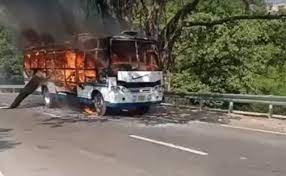Tragedy struck in Jammu district on May 30, when a bus carrying pilgrims to the revered Mata Vaishno Devi shrine met with a horrific accident. The bus skidded off a bridge in the Jajjar Kotli area and plunged into a deep gorge, resulting in the loss of eight lives and leaving 20 others injured.
The ill-fated bus was en route to Katra, a popular base camp for devotees visiting the Mata Vaishno Devi shrine. It was carrying pilgrims who were eagerly anticipating a spiritual journey to the sacred site. However, their hopes and aspirations were shattered in an instant as the unfortunate incident occurred.
As news of the accident spread, local authorities and emergency services swiftly initiated rescue operations to save as many lives as possible. Jammu’s Senior Superintendent of Police, Chandan Kohli, confirmed the grim news, stating that eight individuals had tragically lost their lives, while an additional 20 passengers had sustained injuries.
The scene of the accident was one of chaos and devastation, with the bus lying wrecked at the bottom of the gorge. Rescuers faced immense challenges as they navigated treacherous terrain and worked tirelessly to extract survivors from the mangled vehicle. The injured were rushed to nearby hospitals for urgent medical attention, while the deceased were mourned by their grieving families.
The incident sparked a wave of sorrow and mourning throughout the region. The loss of precious lives, particularly during a religious pilgrimage, cast a pall of sadness over the community. As news spread, friends, family, and concerned individuals gathered to offer support and solace to the affected families.
In the aftermath of the accident, questions naturally arose regarding the cause of the tragedy. Preliminary investigations suggested that the bus had skidded off the bridge, implying that factors such as road conditions, driver error, or mechanical failure could have contributed to the accident. Authorities initiated a thorough investigation to determine the exact cause and to prevent similar incidents in the future.
Transportation safety became a significant concern, with discussions revolving around implementing measures to enhance road infrastructure and minimize the risk of accidents. Attention was also directed towards driver training programs, vehicle maintenance protocols, and the enforcement of safety regulations. The aim was to prevent such devastating incidents and safeguard the lives of those traveling on the region’s roads.
As the community came to terms with the tragedy, support systems were put in place to assist the affected families. Local authorities, social organizations, and religious institutions joined hands to offer financial aid, medical assistance, and emotional support to those grappling with the aftermath of the accident. It was a testament to the resilience and compassion of the human spirit as individuals rallied together to alleviate the suffering of their fellow community members.
The incident served as a somber reminder of the fragility of life and the importance of prioritizing safety in all aspects of travel. It sparked conversations about the need for continuous efforts to improve transportation infrastructure, raise awareness about safe driving practices, and promote responsible behavior on the roads.
In the days that followed, the incident gradually faded from headlines, but its impact lingered within the hearts and minds of those affected. The memories of the lives lost would forever be cherished, while the injured survivors and their families would embark on a long journey towards healing and recovery.
The bus accident in Jammu district on May 30 was a devastating event that claimed eight lives and left 20 others injured. It stood as a stark reminder of the need for ongoing efforts to prioritize transportation safety and protect the lives of those undertaking journeys, particularly during religious pilgrimages like the one to the Mata Vaishno Devi shrine.


